You’ve done the research, you’ve put in the time, and you’ve built the ad, it is funny, or smart, or super informative, but damn it, people aren’t biting.
You thought you did everything right. Your campaigns and messaging are spot on.
But each campaign is just not giving you the results you want.
Well, that's probably because spending time on messaging and copy was absolutely not worth it.
That’s right. You’ve gone and wasted your time and money on something people probably won't even read more than one line of.
But don't worry, there is a solution and it's called marketing segmentation.
Whether you’re launching your first segmented marketing campaign or looking to optimize what’s already somewhat working, we've got your back. In this article, we’re going deep on how to segment your ads and content including:
- Live, revenue-driving examples of market segmentation from highly successful brands
- How to get richer data to segment your audiences to be more accurate
- Easier ways to segment your current data, like your email list.
Now let’s dive in.
Get brand new marketing strategies straight to your inbox. 23,739 people already are!
What Is Market Segmentation?
Market segmentation is grouping your audience and delivering targeted messaging based on specific, predetermined factors. These factors could be activity triggers that your prospect is taking - like certain ad clicks based on UTM parameters or key pages being visited on your site.
You’ve likely seen segmentation happen in a wide range of settings including emails, social ads, PPC campaigns, (opens in a new tab) and website personalization.
Why You Should Implement Market Segmentation
In case you need to convince your marketing team or any other stakeholders, here are a few reasons your brand should take advantage of segmentation:
Higher Revenue
Better segmentation can lead to better personalization, and therefore more revenue.
Seems intuitive, but if you need hard numbers: 2019 Campaign Monitor data shows marketing plans with segmented campaigns saw as much as a 760% increase in revenue.
But here’s the kicker: most of your customers expect personalization.
A report by Segment found 71% of consumers feel frustrated when a shopping experience is impersonal. If you don't meet customers' expectations, you can lose them.
Lower Ad Expenses
Segmenting your audience and messaging towards specific groups of people, optimizes your budget for better performance and potentially lower ad spend. (opens in a new tab) In other words, people viewing more personalized ads are more likely to convert.
Not only that, the major ad networks including Google and Facebook reward personalization. As leads click on your personalized ads, your Google ads quality score (opens in a new tab) increases.
Like if you use remarketing lists (opens in a new tab) for search ads (RLSA) on Google Search.
This lowers your cost per click.
Yes, acquiring customers becomes less expensive when market segmentation is well executed.
Higher Engagement
Beyond lower CPCs, you can engage your email lists at higher rates than ever before. A study by Mailchimp found segmented email campaigns have a 14.31% higher open rate and a 100.95% higher click-rate than non-segmented email campaigns. Your email marketing goals might include:
- Higher open rates- the percentage of people that open your emails out of the contacts who received that specific email message.
- Higher clickthrough rates- the percentage of email recipients who clicked on one or more links within an email.
- Higher conversion rates- the percentage of email recipients who clicked a link in an email and completed a desired action. Such as purchasing your product or scheduling a demo.
Reallocate Budgets
Here’s where reviewing your analytics can serve your brand even better.
As you run segmented campaigns, you’ll likely discover a higher buying response from specific audiences. Then you may end up shifting more of your marketing budget towards specific groups.
Or develop new products for your more engaged audiences, giving you even more revenue opportunities.
Now, let’s take a look at how marketers segment their potential customers.
5 Types Of Market Segmentation
1. Firmographic Segmentation
Firmographic segmentation categorizes B2B customers into groups based on factors such as:
- Company size (How many employees do they have? What series of funding did they last receive?)
- Vertical (What industry are they in? For example, are your target customers hotels, spas, and other hospitality businesses?)
- Sales stage in your CRM
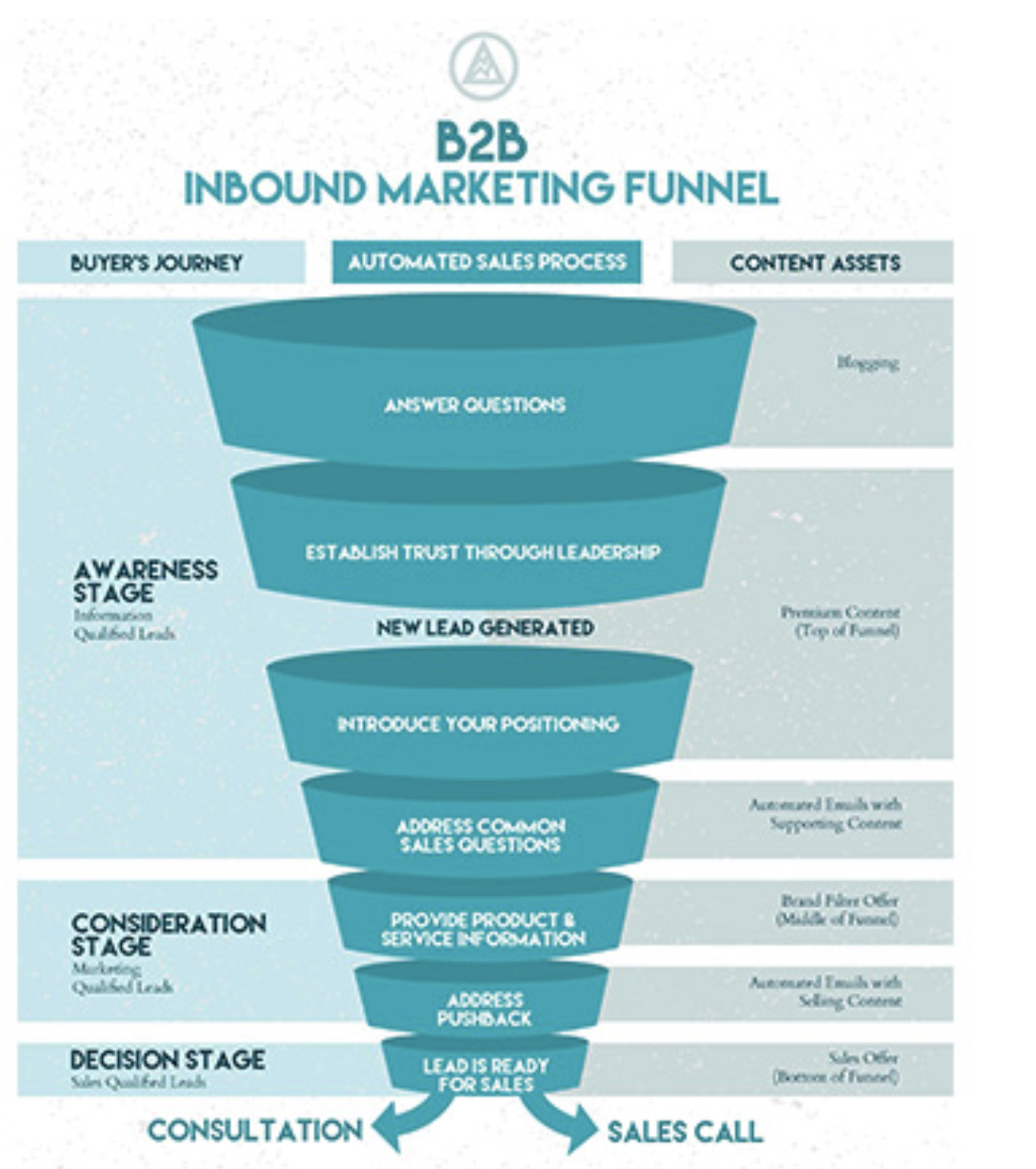 Traditional marketing funnel[/caption]
Traditional marketing funnel[/caption]Firmographic Segmentation Examples
The project management platform Monday.com customizes their Facebook ad copy by industry. The example below targets real estate companies.
[caption id="" align="aligncenter" width="590"]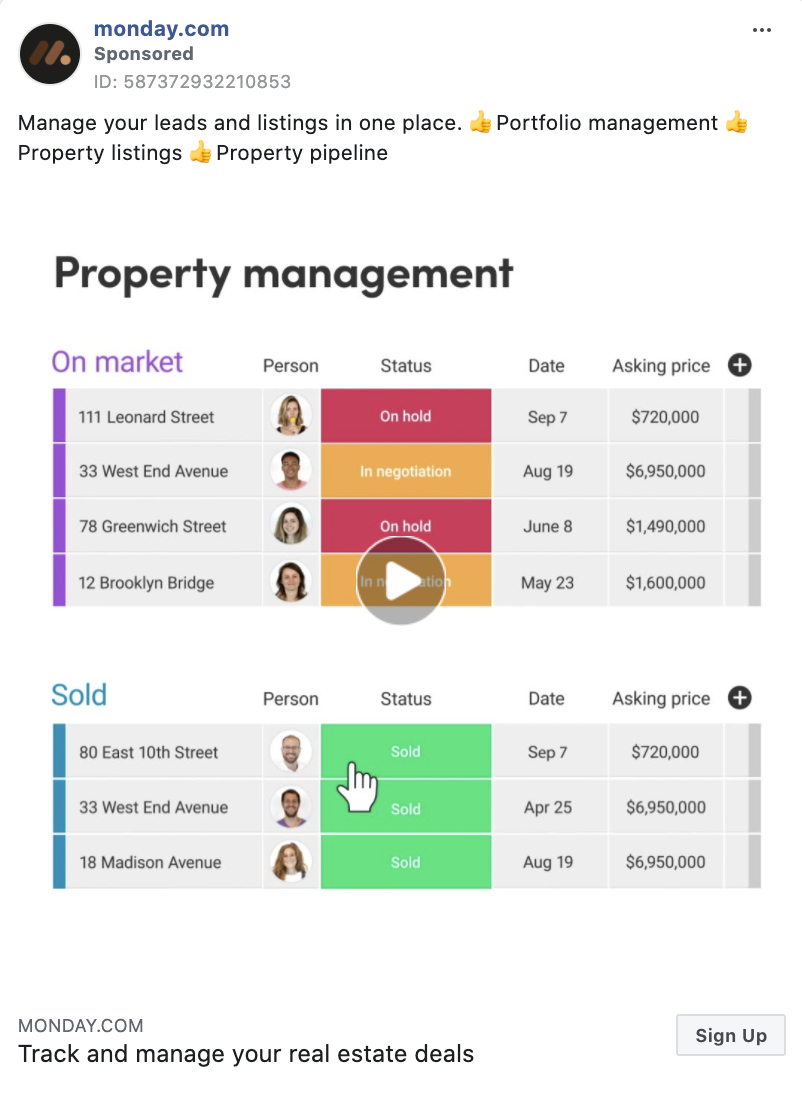 Facebook ad copy from Monday.com retargeting real estate companies[/caption]
Facebook ad copy from Monday.com retargeting real estate companies[/caption]Clicking on the “Sign Up” CTA on the above ad takes Facebook users to a landing page, also personalized for the real estate vertical:
[caption id="" align="aligncenter" width="590"] Monday.com industry-targeted landing page[/caption]
Monday.com industry-targeted landing page[/caption]Segment creates customized landing pages for product managers and engineers based on their day-to-day responsibilities.
For product managers, they are constantly reviewing their customer’s behavioral data.
[caption id="" align="aligncenter" width="590"] Segment product manager landing page[/caption]
Segment product manager landing page[/caption]With engineers, segment emphasizes how easy it is to integrate their API.
[caption id="" align="aligncenter" width="590"]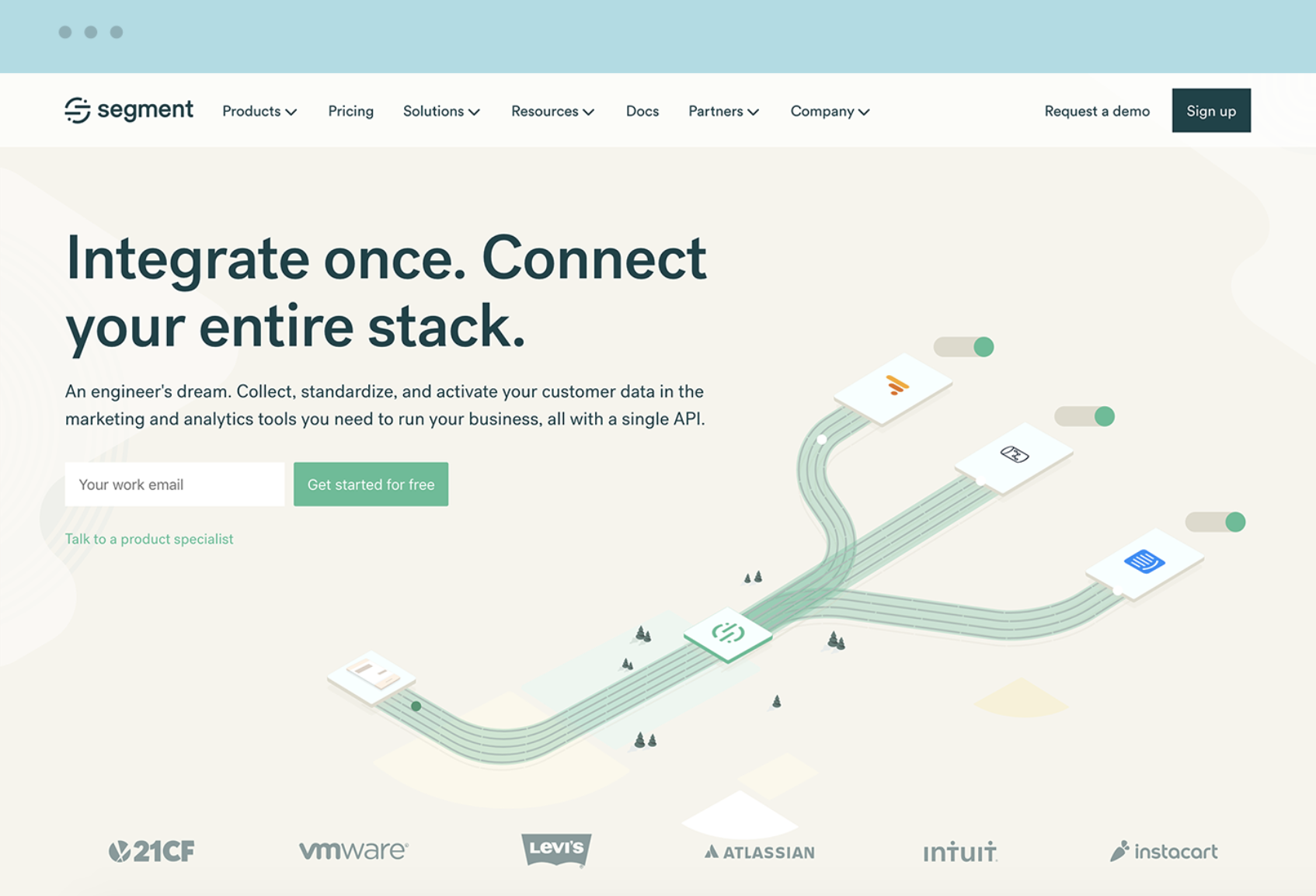 Segment engineer-targeted landing page[/caption]
Segment engineer-targeted landing page[/caption]B2B organizations taking their first steps to segment their content: start personalizing by developing marketing campaigns based on your lead’s industry. As your market segmentation campaigns mature, you can add more layers of personalization.
For example, if you’re targeting hospitality organizations you can develop messaging highlighting industry-specific challenges. Then create role-specific landing pages and ad copy. This can be the primary user or based on people within that organization who are stakeholders in purchasing your product or service.
2. Behavioral Segmentation
Behavioral segmentation is the grouping of customers based on actions they take around your business’ content, app, marketing, or website.
Delivering highly personalized content requires strategies to meet people where they are and how they are. Here are a few strategies that incorporate behavioral data...
Browsing History
You can’t treat all your website visitors the same. The ad’s CTA, offer, and linked landing page you send to someone that’s likely never heard of you versus someone who has purchased from you should be different.
Behavioral marketing (opens in a new tab) also needs to take into account users who visit your website but do not convert. Retargeting campaigns (opens in a new tab) pick up where they left off on your website and get you even more conversions.
Web site visitors retargeted with display ads are 70% more likely to convert on your website. This is why gauging your PPC traffic's temperature (opens in a new tab) is so vital.
[caption id="" align="aligncenter" width="590"]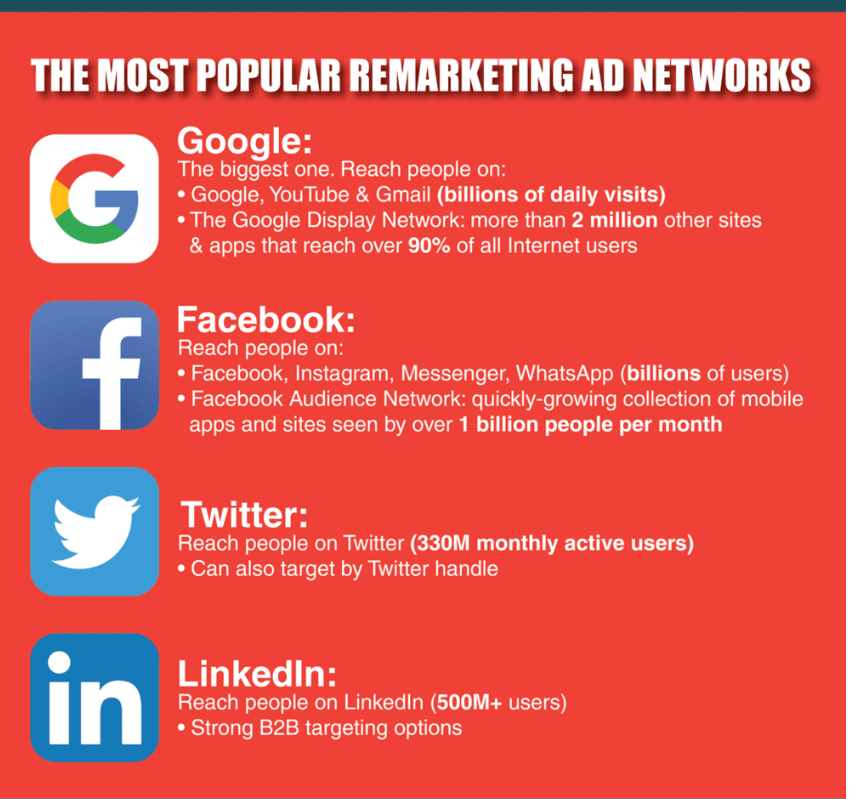 Popular remarketing ad networks
Popular remarketing ad networksImage Source[/caption]
For example, Adobe uses retargeting ads based on the products you’ve viewed on its website through a tracking pixel.
[caption id="" align="aligncenter" width="590"]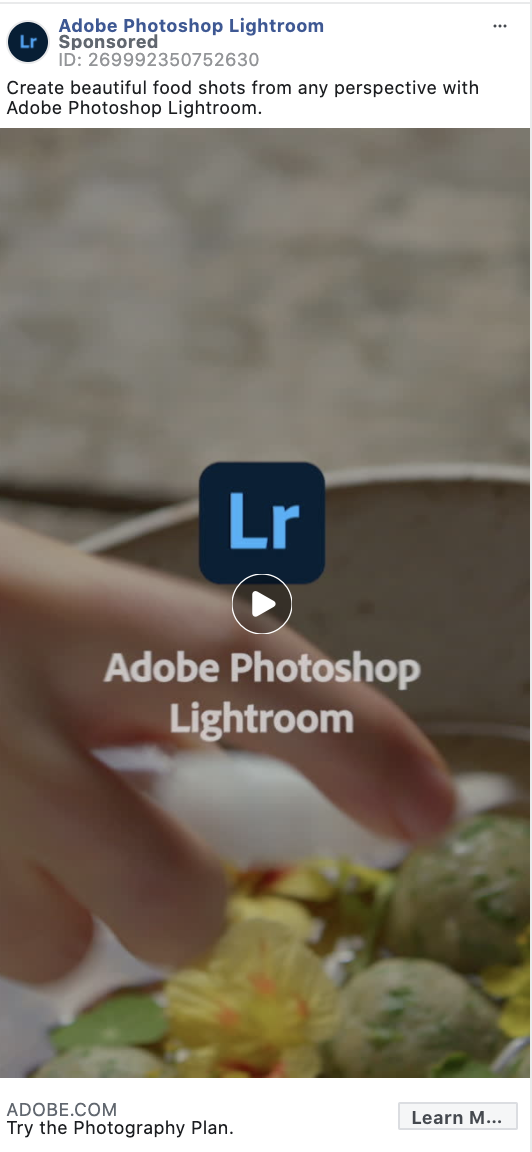 Adobe Photoshop Lightroom Facebook ad[/caption]
Adobe Photoshop Lightroom Facebook ad[/caption]You can also send targeted emails when you want to push your website visitors to complete an action like Girlboss, a networking and resource site for ambitious women. Using CampaignMonitor, they create segmented campaigns including:
- Email reminders to people to complete their site profiles
- Personalized event invites based on the content read on their website
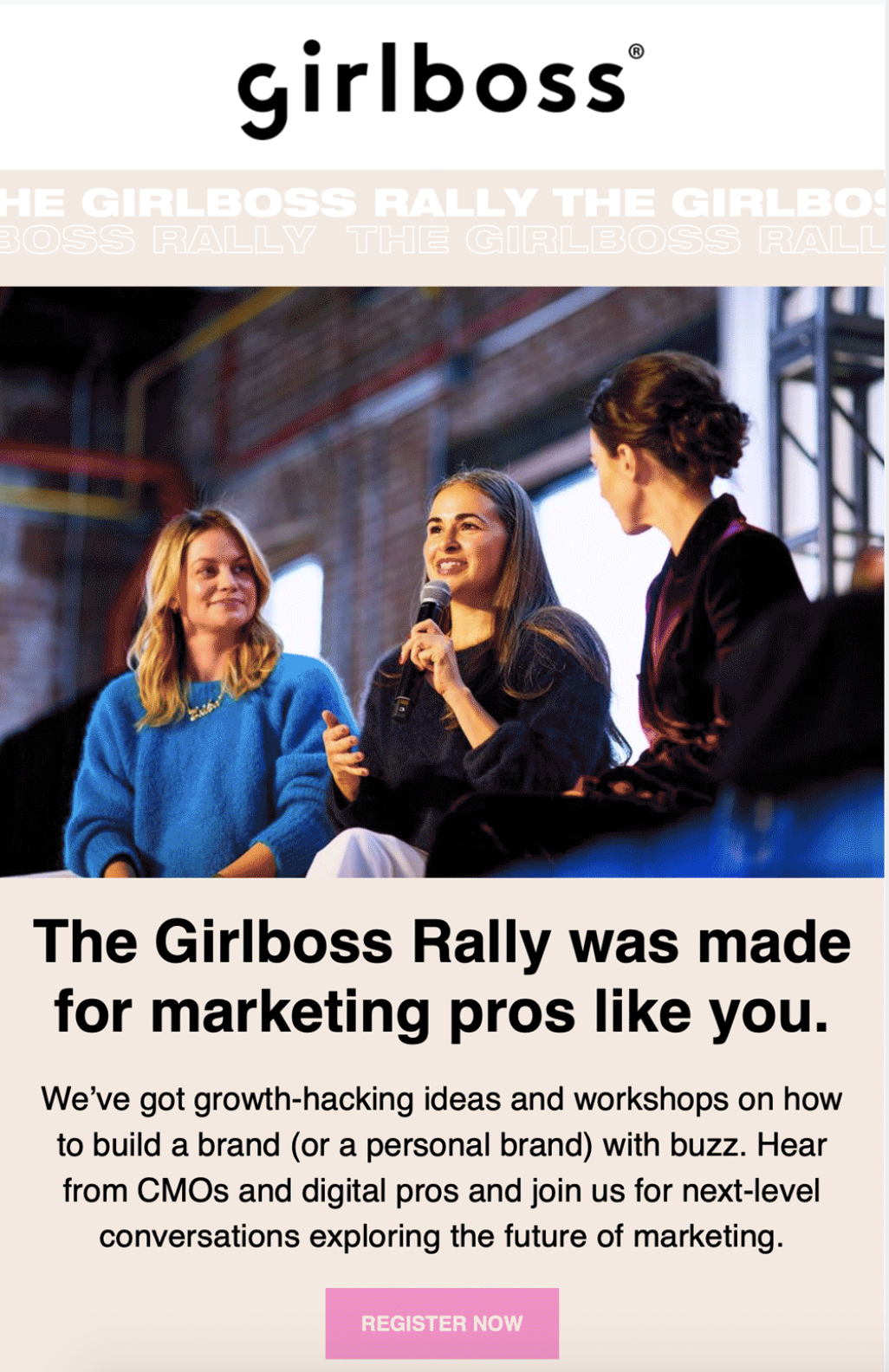 Email for Girlboss Rally[/caption]
Email for Girlboss Rally[/caption]Search Intent
People search not only for brands on Google, in some cases, they even type in specific product models. Our Keyword Tapering (opens in a new tab) technique lets you bid more competitively for a higher ROAS (return on ad spend) on PPC ads based upon these high intent searches.
Purchase Decisions
One of the key metrics you’re likely tracking is your customer’s lifetime value (LTV) since repeat customers make up 41% of eCommerce revenue in the United States.
With increasing a customer's LTV, consider:
- What items do they first purchase?
- How long does it take them to complete a second order and what items do they buy?
- What items does your data show someone is likely to buy together?
Amazon uses similar information (and other much larger data points) to their advantage. According to McKinsey research, 35% of Amazon’s sales come from its product recommendations engine.
On the ‘Your Amazon.com’ section of their website, Amazon users can view a selection of products based on their past shopping.
[caption id="" align="aligncenter" width="590"]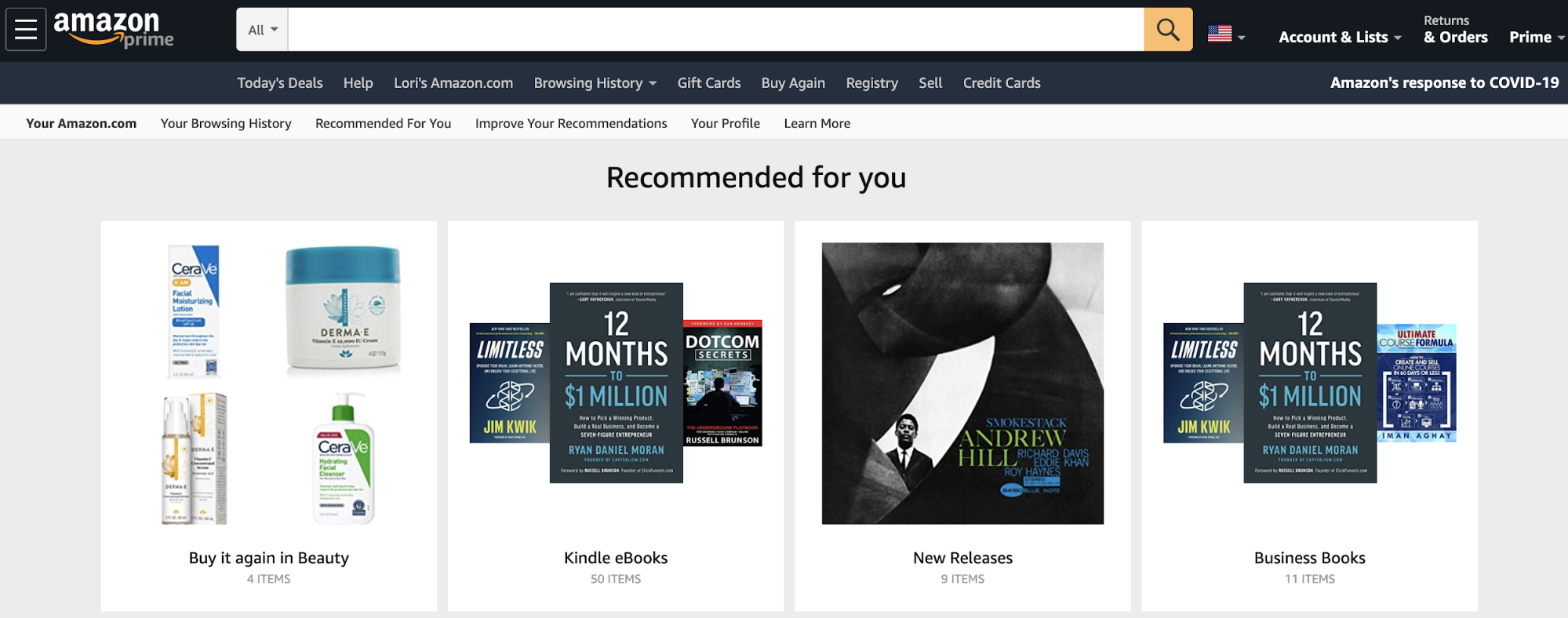 Your Amazon product recommendations[/caption]
Your Amazon product recommendations[/caption]For eCommerce brands, you can also display personalized product recommendations to your customers while they shop. Use plugins like Upsell Recommendations and Recommendify to quickly get up and running.
Reward customers that complete desirable actions using automated email solutions. After someone spends $200 or more, Sephora emails a 20% discount.
[caption id="" align="aligncenter" width="590"]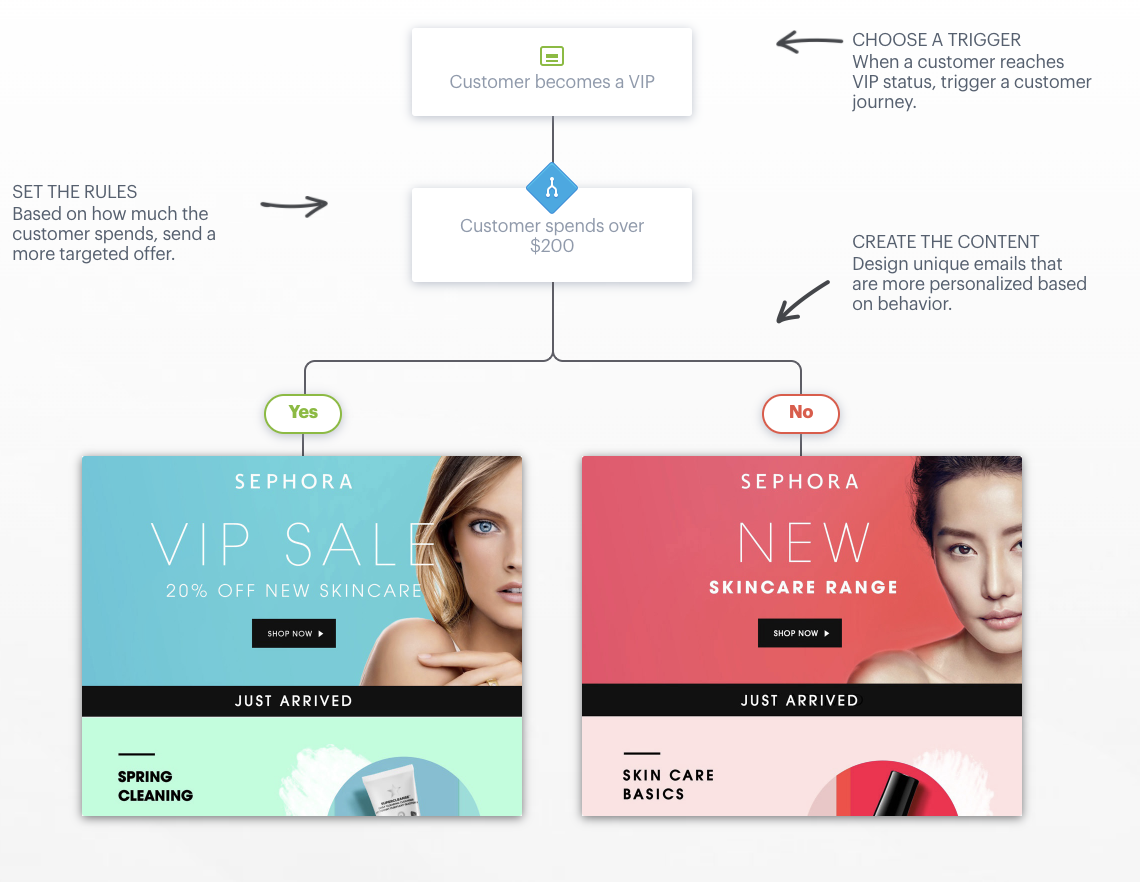 Sephora’s rule-based email funnel
Sephora’s rule-based email funnel Image Source[/caption]
Consider also if customers converted through a specific channel and personalize your content based on that. Book Like a Boss emailed its customers that purchased a plan through AppSumo a one-time offer to upgrade their scheduling software.
[caption id="" align="aligncenter" width="590"]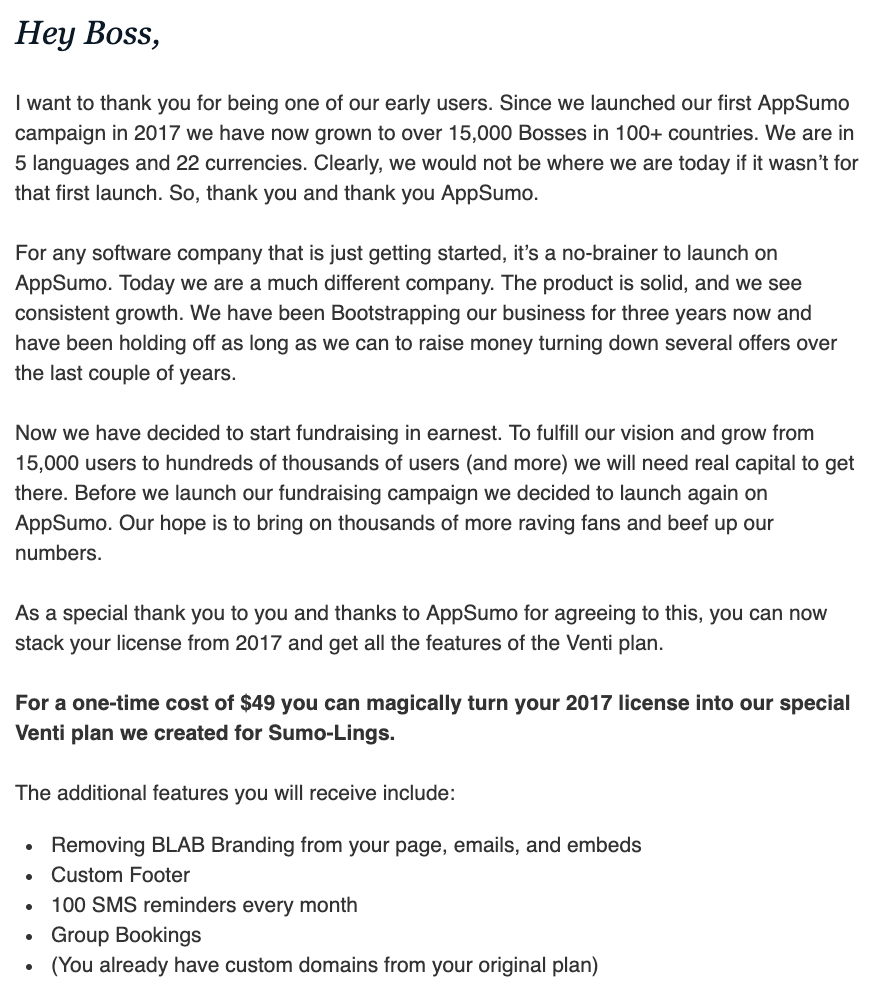 Book Like a Boss upsell email to customers that purchased through AppSumo[/caption]
Book Like a Boss upsell email to customers that purchased through AppSumo[/caption]The above email generated five figures.
[caption id="" align="aligncenter" width="590"] Email with CEO Nachum Klingman[/caption]
Email with CEO Nachum Klingman[/caption]Time-Based
Any sort of productized service can anticipate their customer’s needs and target them based on when they access your product.
For example, Starbucks knows their regular morning customers might be open to a second coffee in the afternoon. They offer happy hour prices via email marketing and mobile app notifications.
[caption id="" align="aligncenter" width="590"] Starbucks mobile push notification[/caption]
Starbucks mobile push notification[/caption]Engagement-level
Reward users for brand loyalty with offers as simple as buy nine burritos, get the tenth one free. You can even add scarcity into your loyalty rewards emails by offering a discount that expires in a few weeks like GNC does.
[caption id="" align="aligncenter" width="590"]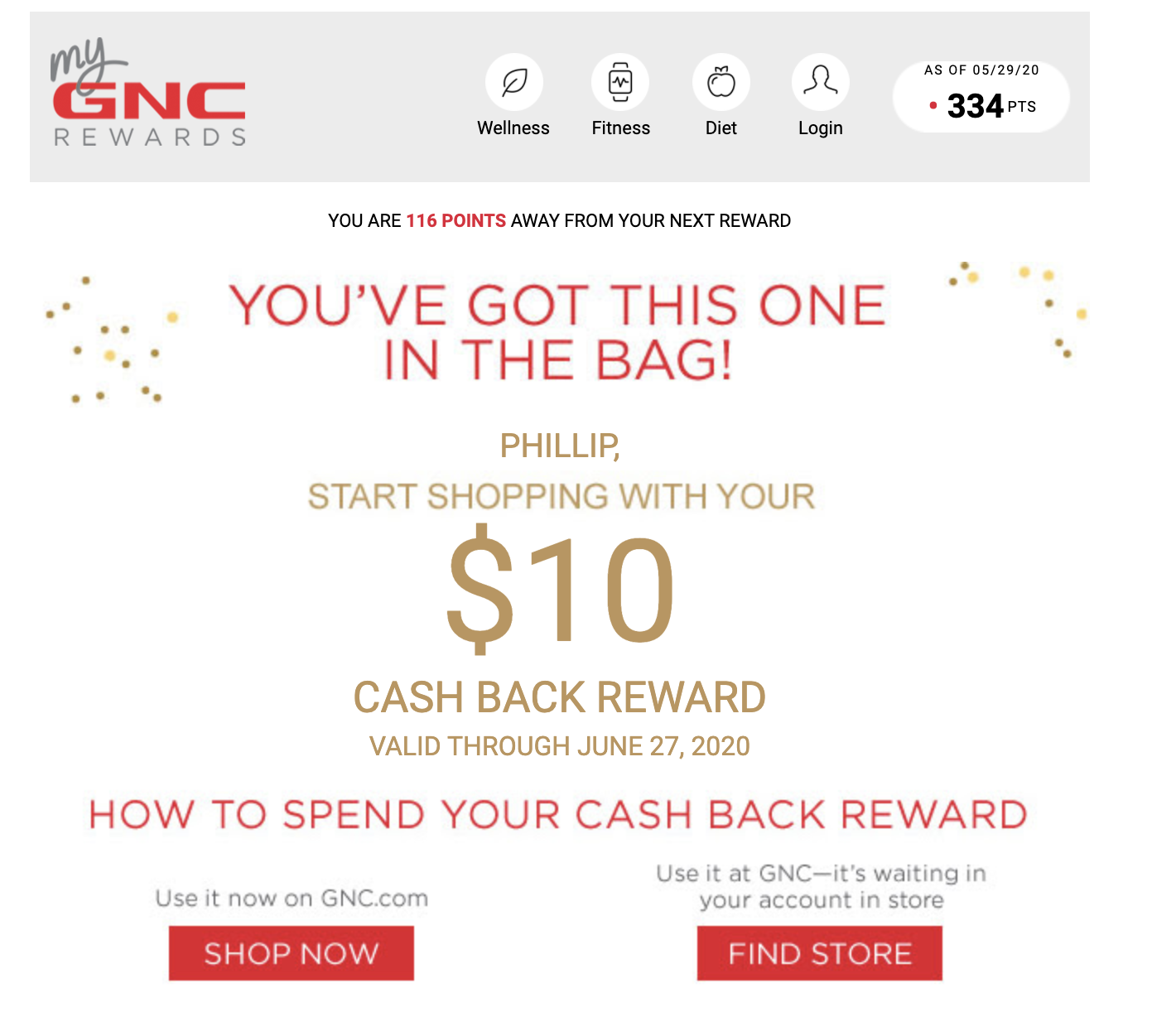 GNC discount email[/caption]
GNC discount email[/caption]Another way you can reward your customers by email: offer a deal to your active customers for renewing a subscription or service early.
[caption id="" align="aligncenter" width="590"] Carbonite subscription renewal email[/caption]
Carbonite subscription renewal email[/caption]You can also re-engage customers who haven’t purchased in a while. Like Pinkberry does, by offering customers on their email list a free frozen yogurt.
[caption id="" align="aligncenter" width="590"]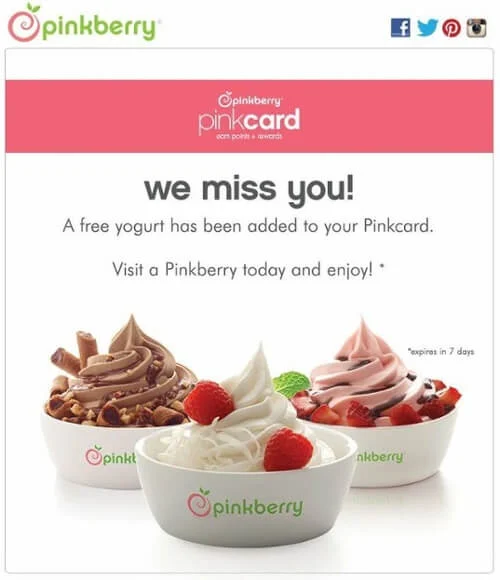 Pinkberry re-engagement email[/caption]
Pinkberry re-engagement email[/caption]3. Geographic Segmentation
Geographic Segmentation is a form of segmentation where marketing’s personalized based on factors such as a lead’s:
- City
- State
- Country
- Zip Code
- Regional climate
Geography Segmentation Examples
For an email campaign, Airbnb offered a 10% discount offer based on a subscriber's location.
[caption id="" align="aligncenter" width="590"] Airbnb discount email[/caption]
Airbnb discount email[/caption]Clicking the “Explore discounted stays” button in the email takes Airbnb users to nearby, discounted vacation spots.
[caption id="" align="aligncenter" width="590"]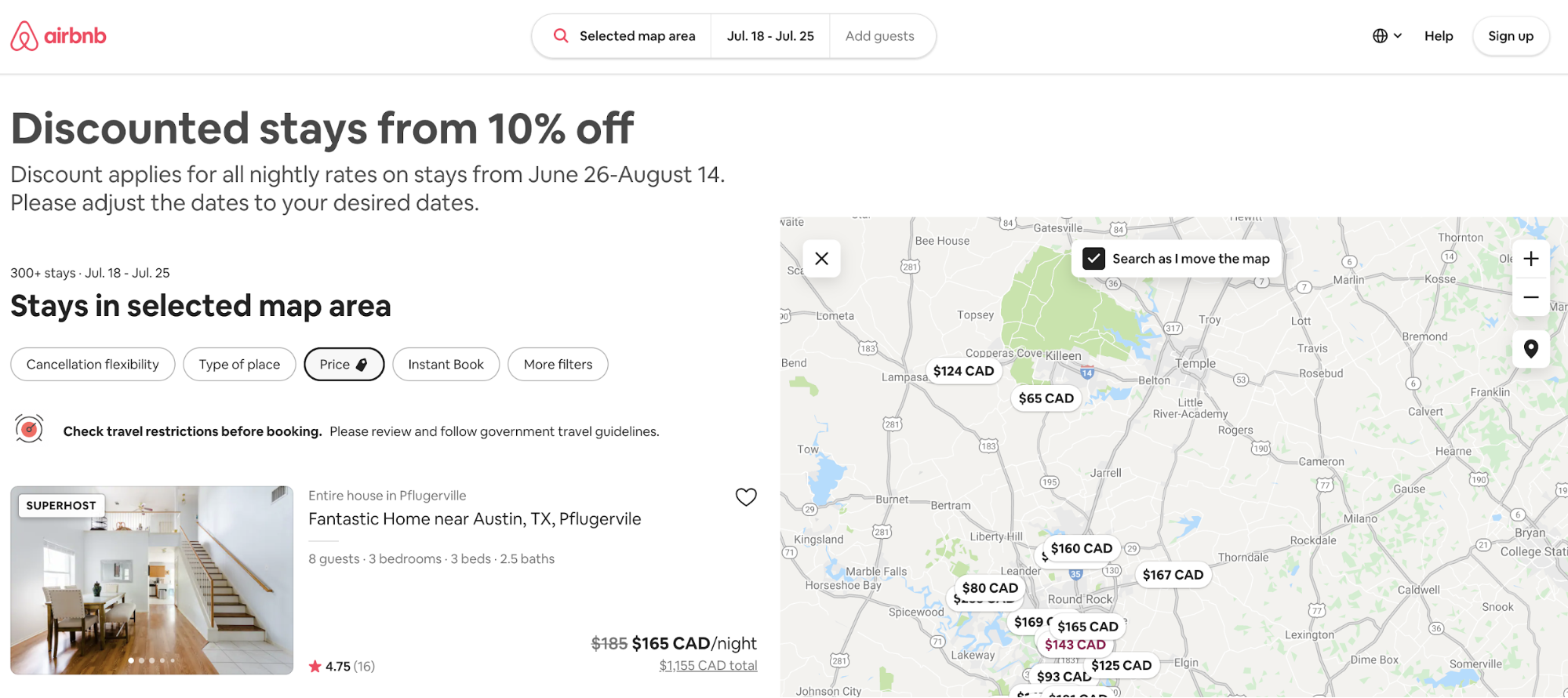 Airbnb geo-targeted landing page[/caption]
Airbnb geo-targeted landing page[/caption]You can even geographically personalize your content based on the season. For example, Sleeman Beer runs awareness campaigns on Facebook and Instagram for their summer-themed beer cases that can be used as a box for bag tossing.
[caption id="" align="aligncenter" width="590"] Sleeman Beer Facebook ad copy[/caption]
Sleeman Beer Facebook ad copy[/caption]4. Demographic Segmentation
Demographic Segmentation covers traits like age, gender, marital status, family size, and income.
Demographic Segmentation Examples
H&M’s ad creative targets multiple age groups. For example, H&M’s back to school campaign developed retargeting ads towards university students:
[caption id="" align="aligncenter" width="590"] H&M display ad[/caption]
H&M display ad[/caption]While the below campaign centers around new parents.
[caption id="" align="aligncenter" width="590"]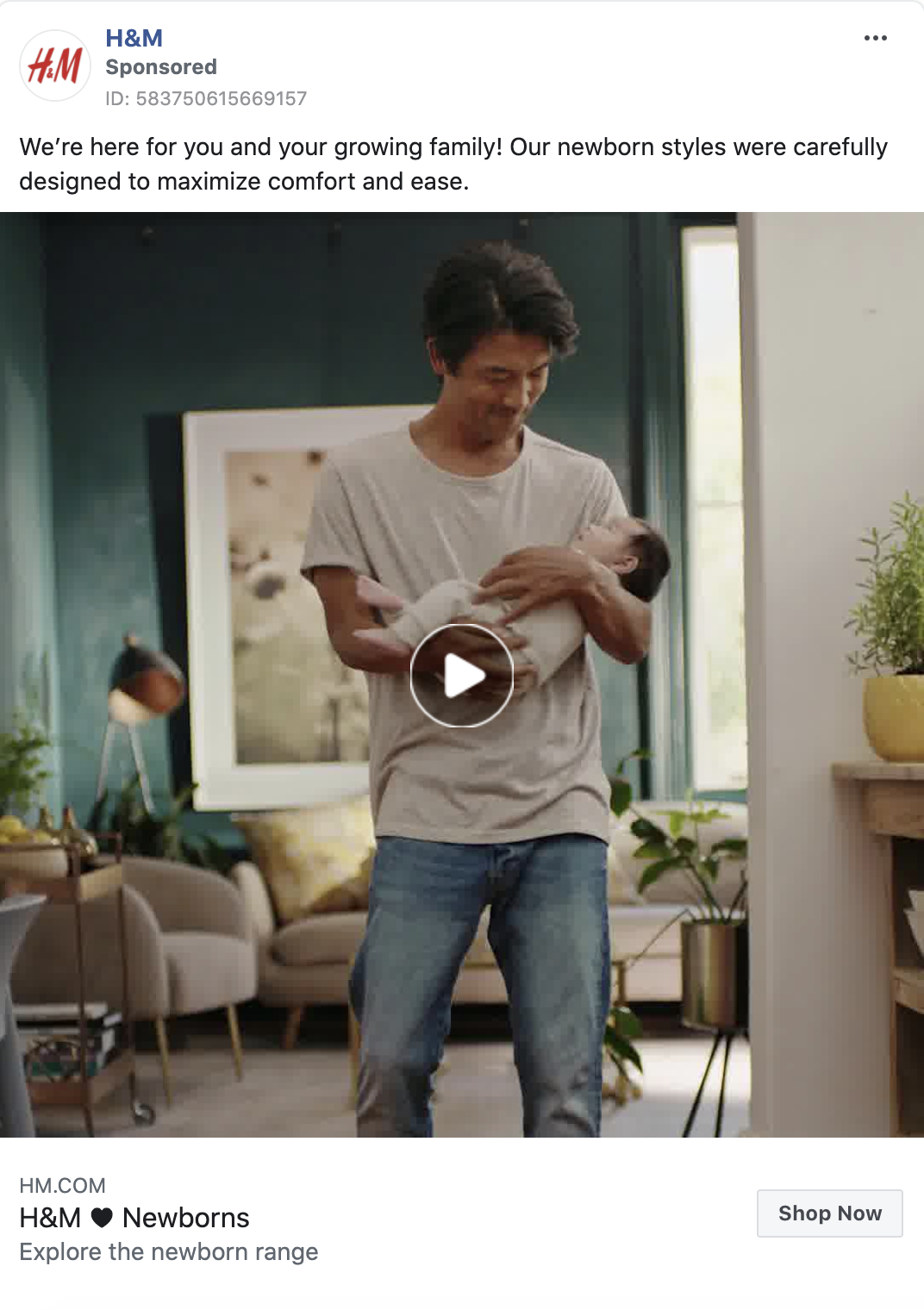 H&M Facebook ad copy[/caption]
H&M Facebook ad copy[/caption]You can also segment your audience as they reach a milestone such as their wedding or birthday.
Alamo Drafthouse offers a free movie ticket to its loyalty program members via email on their birthday.
[caption id="" align="aligncenter" width="590"] Alamo Drafthouse birthday promotion email[/caption]
Alamo Drafthouse birthday promotion email[/caption]Birthday emails generate 342% higher revenue than promotional emails.
5. Psychographic Segmentation
Psychographic Segmentation entails an audience’s opinions, interests/activities, personality traits, lifestyle, and social status.
Psychographic Segmentation Examples
Years ago, every keyword you’re targeting for PPC ads needed a separate landing page. If you had many keywords and products, this was a huge time sink. Now you can use dynamic text so you have one landing page for each ad group.
One specific part of your audience might be more intrigued by a hiking backpack for an afternoon hike versus trekking backpack for a multi-day journey. Fortunately, your PPC ads and landing page can reflect specific searches thanks to dynamic text.
[caption id="" align="aligncenter" width="590"]
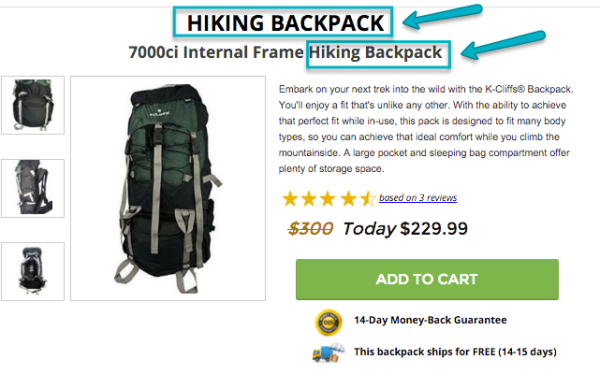 K-Cliffs Backpack's dynamic text landing pages
K-Cliffs Backpack's dynamic text landing pagesImage Source[/caption]
Interest-Based Targeting
Brands tailor everything from their ad creative to products based on individuals' interests (opens in a new tab).
Johnnie Walker developed a whiskey inspired by Game of Thrones. They developed a dedicated product landing page so they can funnel people interested in GOT and whiskey to order online.
[caption id="" align="aligncenter" width="590"] Johnnie Walker’s Game-of-Thrones-themed product page[/caption]
Johnnie Walker’s Game-of-Thrones-themed product page[/caption]WP Engine uses Facebook ads to target people who are interested in Entrepreneur magazine.
[caption id="" align="aligncenter" width="590"]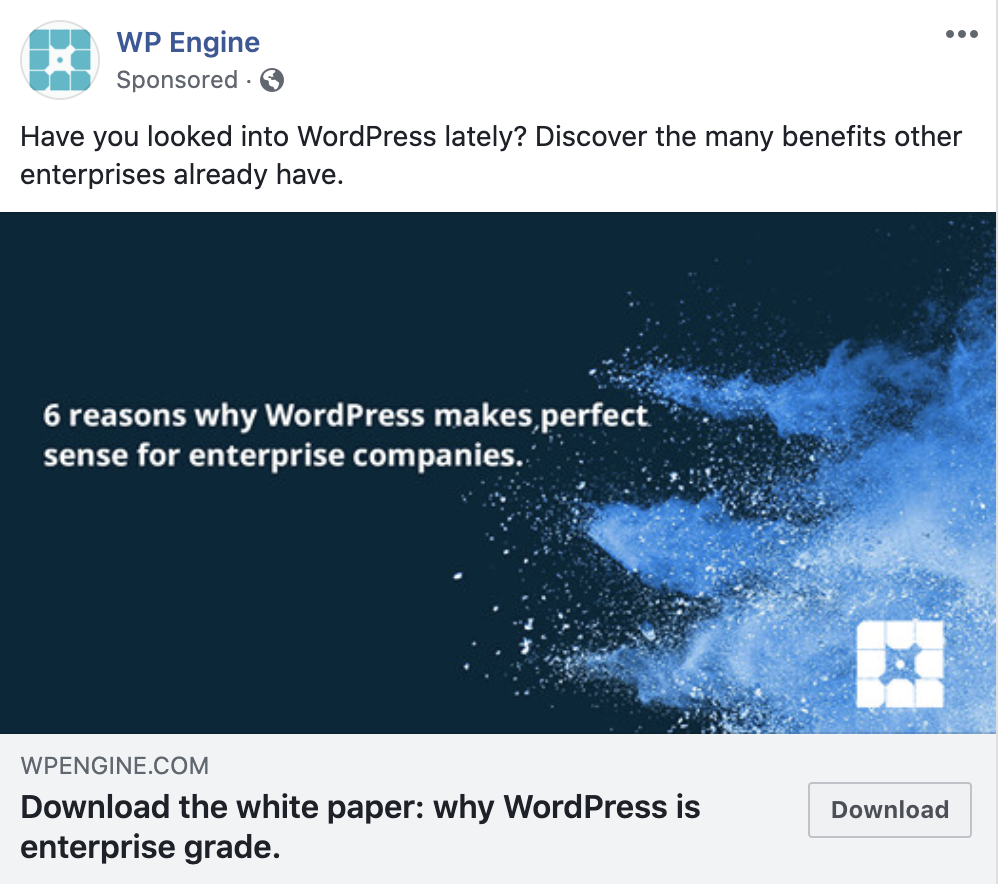 WP Engine Facebook ad copy[/caption]
WP Engine Facebook ad copy[/caption]Values-Based Targeting
Grove’s Facebook ad messaging reinforces an audience’s set of beliefs. And targets people more likely to seek sustainable solutions and will more likely want to cut down on plastic waste compared to a more general audience.
[caption id="" align="aligncenter" width="590"]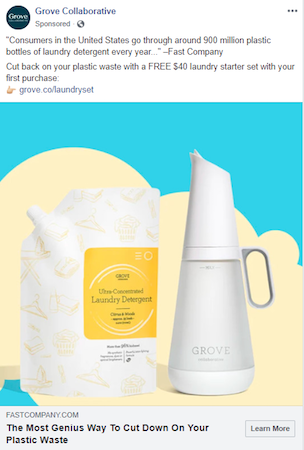 Facebook ad for Groove Collaborative based on their sustainable solution[/caption]
Facebook ad for Groove Collaborative based on their sustainable solution[/caption]All that said, if you’re looking for more specific examples of your competitor’s market segmentation strategy, let me show you how to spy on their ads.
How To View Your Competitor’s Targeting & Ads
To check out how your competitors are geographically targeting on Facebook and Instagram:
Visit their Facebook Fan Page and select “See More” under “Page Transparency”.
[caption id="" align="aligncenter" width="590"]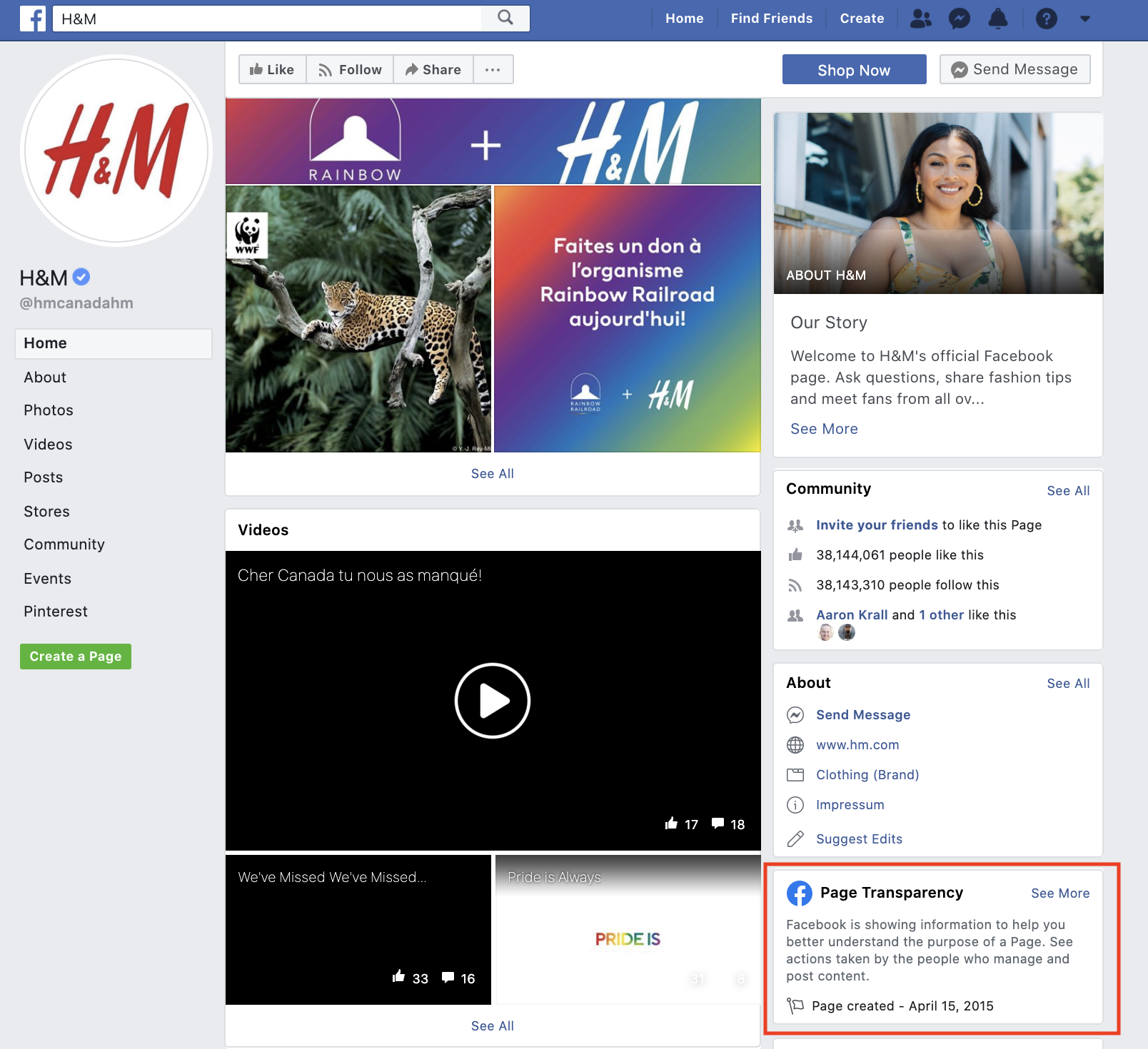 H&M’s Facebook page[/caption]
H&M’s Facebook page[/caption]Next click “Go to Ad Library”.
[caption id="" align="aligncenter" width="590"]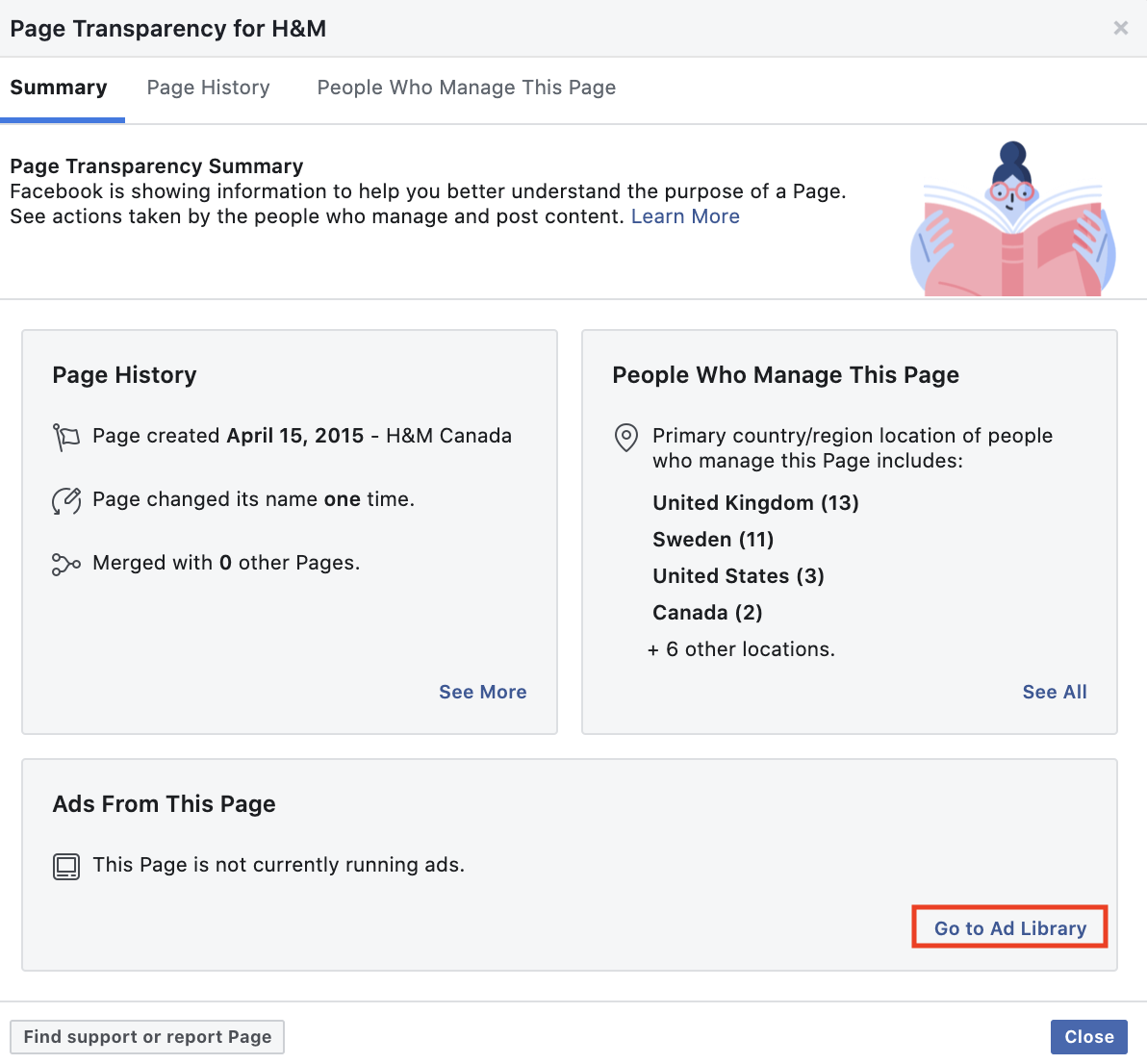 Page Transparency view on Facebook[/caption]
Page Transparency view on Facebook[/caption]Filtering ads for Facebook and Instagram users in Australia you can view both their ads and landing pages.
[caption id="" align="aligncenter" width="590"] H&M ads running targeting Facebook and Instagram users in Australia[/caption]
H&M ads running targeting Facebook and Instagram users in Australia[/caption]For the Google Ad Network, learn more about PPC Spy Tools (opens in a new tab) to discover what your competitors are up to.
7 Ways To Collect Data For Segmenting Your Audience
Now that you’ve seen all the ways you can personalize your ad funnel, let's look at seven strategies you can use to gather data for optimizing your ads and content.
1. Survey Your Customer Base
Customer surveys can be a powerful resource to gather more information about your different target audiences beyond gender and age. First, identify the goals of your survey:
- Are you looking to gather firmographic criteria such as their role-specific challenges? (Groove has a great live survey you can see as an example for B2B brands)
- Are you seeking spending, reading, or other behavioral habits?
- Do you intend this survey to reach a specific geographic location only?
- Do you want to restrict your target market by any demographic factors?
- What habits, values, or interests do you associate with your target segment that you believe are unique to them? And what insights are you looking to gain from that?
Then once you have an understanding of the specific segmentation characteristics you’re trying to gather, you can create a list of questions that reflect your strategy.
With those questions, you can use Typeform to send out your survey. Email your list to get a better understanding of who they are. Incentivize completing your survey with a small giveaway.
[caption id="" align="aligncenter" width="590"]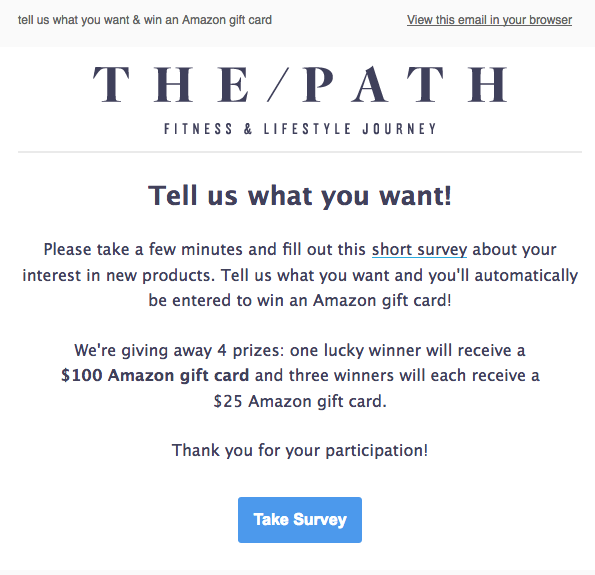 The Path’s survey giveaway email[/caption]
The Path’s survey giveaway email[/caption]If you don’t have an email list or want more data, promote the survey like you would content.
[caption id="" align="aligncenter" width="590"]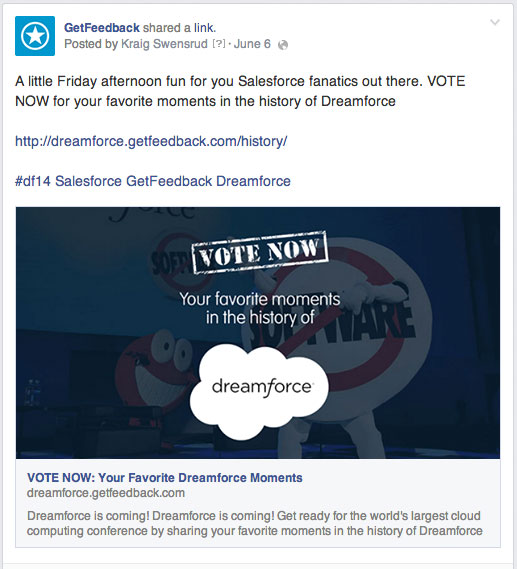 GetFeedback gathering feedback through a LinkedIn ad[/caption]
GetFeedback gathering feedback through a LinkedIn ad[/caption]Consider also platform-specific survey options like running Instagram Story interactive poll ads (opens in a new tab).
2. Customer Interviews
Another great resource for completing market research about specific audiences is interviewing. Aim to interview at least five people for each group you’ve identified as a persona.
For example, Shopify might ask their customers through interviews questions like:
What was going on that made you use Shopify?
What did your selection process look like? Why did you decide on Shopify?
What other channels are you selling on currently? How has that experience gone compared to using Shopify?
What’s the first thing you do when you wake up? Why?
Where do you go to learn more about managing and growing your store?
Pro-tip: The most valuable insights come up as you ask follow up questions. Try questions like “That’s really interesting, can you tell me more about that?”
Also, avoid leading questions such as “As you’re drinking coffee, you’re on social media right?” Leading questions lead to false qualitative data.
3. Lower the Barrier to Entry
One way you can quickly gather data and segment your potential new customers are lead generation (opens in a new tab) forms. For most businesses, the most common types of lead generation forms include contact forms, registration forms (for a specific event such as a webinar), and newsletter signup forms.
Many contact forms ask site visitors their name, phone number, and email address. Lengthier B2B forms may request more details like company size, revenue, and job role.
But here’s the thing: seeing a long-form discourages most people. One study found reducing the number of fields on a form from 11 to 4 resulted in a 120% increased conversion rate.
Still, there are strategies you can use to incentivize site visitors to complete your lead form. Provide value to your lead in exchange for completing all fields. For example, we provide a proposal (opens in a new tab) with free optimizations tips and competitive research anyone can leverage.
[caption id="" align="aligncenter" width="590"]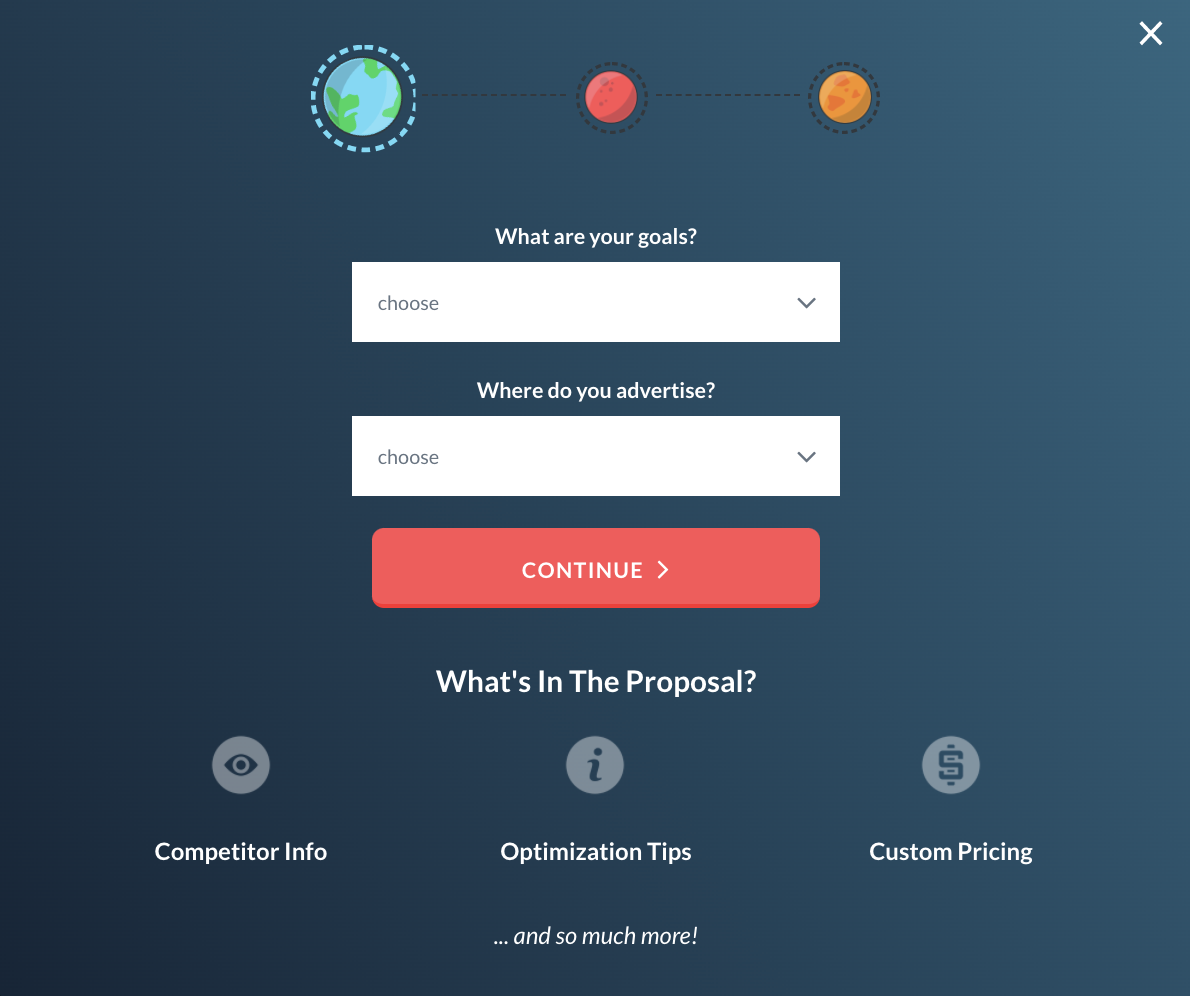 Our get a proposal form[/caption]
Our get a proposal form[/caption]We also break down our forms into more snackable steps so they are more likely to complete it using the Breadcrumb Technique (opens in a new tab).
4. Quizzes
eCommerce stores, online courses, and all sorts of other businesses use quiz funnels to segment and grow their audiences.
[caption id="" align="aligncenter" width="590"] I Will Teach You To Be Rich home page[/caption]
I Will Teach You To Be Rich home page[/caption]Quiz funnels use multiple choice questions to segment people into email lists. Generally, quizzes ask between 7-15 questions to gather information about:
- General details about their background (eg. “Are you currently single?”)
- Their current challenges (eg. “What is the biggest problem you’re facing with growing your business?”)
- A reader's budget
Most quizzes appear at the top of the funnel so you gain data from the answers you receive. And new potential customers! Then you can develop segmented drip campaigns addressing the challenges each lead identified in your quiz.
5. Facebook Audience Insights
Explore specific personas on Facebook Audience Insights (opens in a new tab) through the people connected to your page and Custom Audiences.
A Custom Audience (opens in a new tab) uses data tracked from the Facebook pixel on your website or a landing page. There are four sources to create a Custom Audience:
- Customer file based on your existing customers, e.g. lists of email accounts, phone numbers or app IDs
- Website traffic (specific website visitors, converters, non-converters)
- App activity
- Engagement on Facebook
Check out our step-by-step guide (opens in a new tab) to creating Custom Audiences.
Once you’ve created custom audiences based on a behavior such as someone that viewed your landing page and didn’t convert, you can jump into Audience Insights.
Under the Lifestyle tab on Audience Insights, Facebook lets you target users based on shared demographics, interests, affinities, and other data points.
[caption id="" align="aligncenter" width="590"]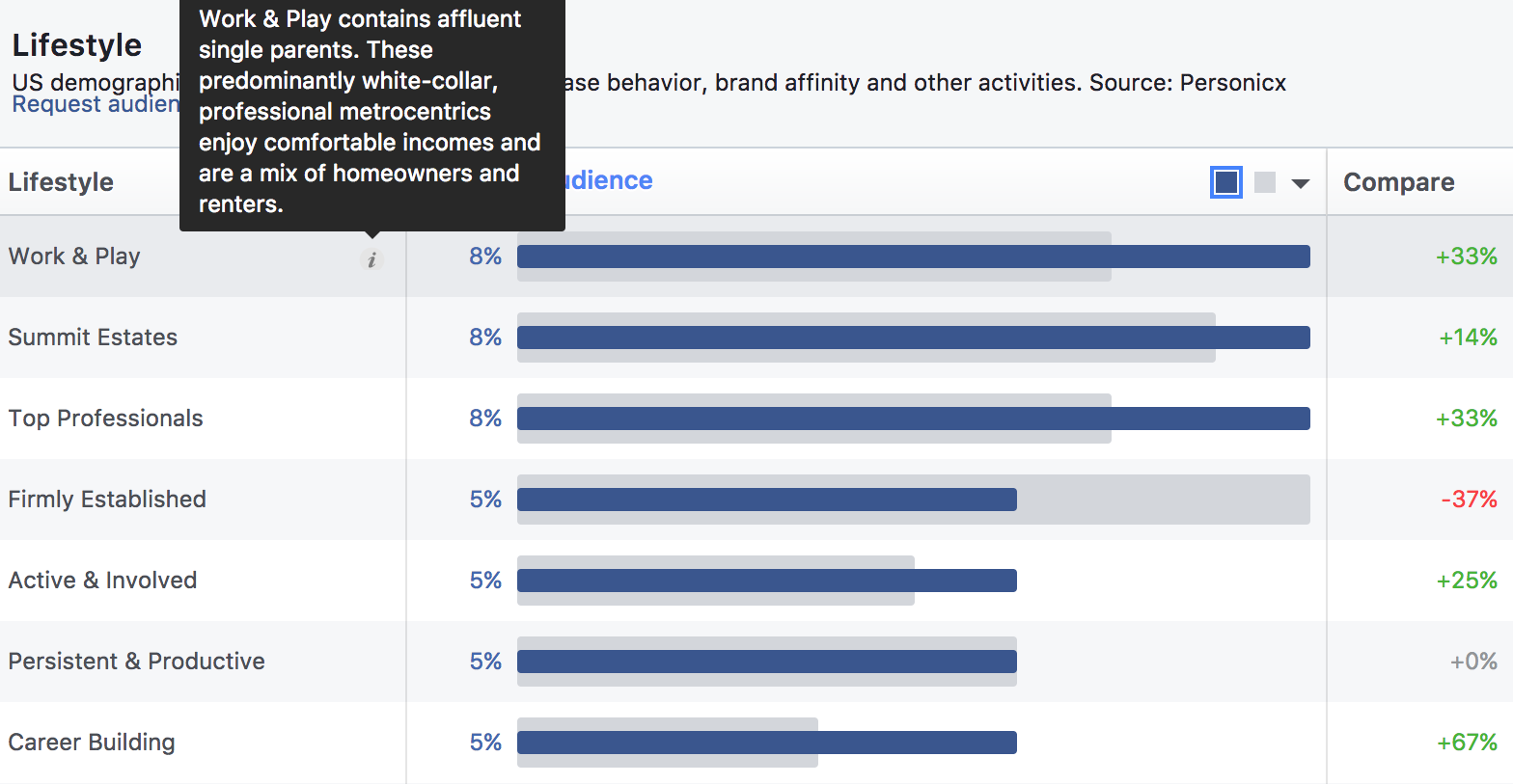 Facebook Audience Insights Lifestyle chart[/caption]
Facebook Audience Insights Lifestyle chart[/caption]After reviewing this data you can personalize your ad and landing page copy further to speak to each persona.
6. Hidden Interests
Facebook caps the number of interests you can see on Audience Insights.
The good news: you can still view additional data and create more granular targeting on Facebook through the Facebook Marketing API (opens in a new tab).
Facebook Marketing API (Application Programming Interface) lets you see more raw data without the sleeker interface of Audience Insights.
Sign up to get a Facebook for Developers account and create an app ID.
[caption id="" align="aligncenter" width="590"] Facebook for Developers’ app ID creation page[/caption]
Facebook for Developers’ app ID creation page[/caption]Then you can generate an access token to explore the API’s data.
Ad Interest Method
The Ad Interest method connects to the API and displays similar interests based on the URL you enter:
https://graph.facebook.com/search?type=adinterest&q=[iPad]&limit=10000&locale=en_US&access_token=your-access-token
First, paste the above URL into a clipboard or browser window.
Then replace “iPad” with any keyword you wish.
Copy your token. Replace “your-access token” with your copied token.
Then paste that URL into a browser window to view the data.
Sticking with interests related to iPad you’ll see related interests including the App Store and specific iPad models like iPad Pro.
[caption id="" align="aligncenter" width="590"]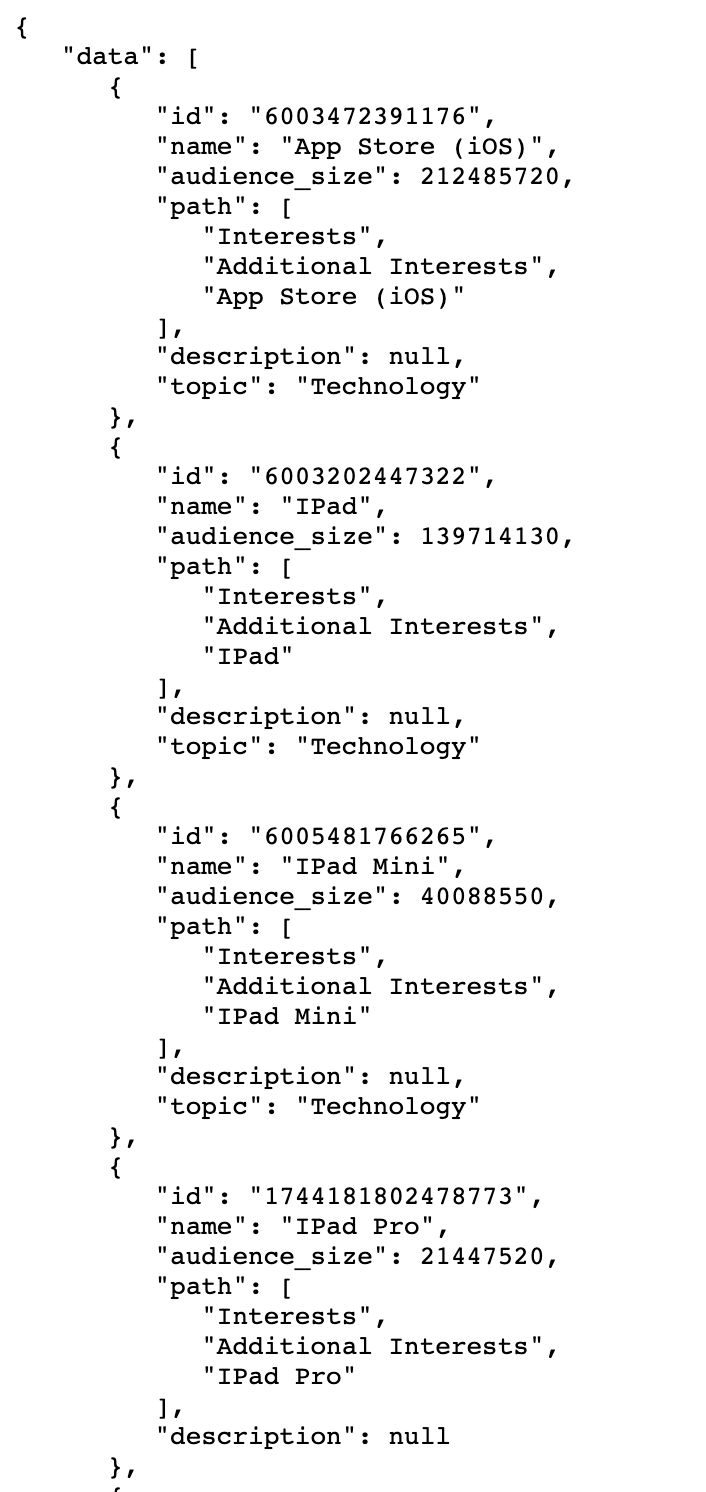 Ad Interest method results for “iPad”[/caption]
Ad Interest method results for “iPad”[/caption]Ad Interest Suggestion Method
Although it doesn’t work for every keyword, you can also try searching using the Ad Interest Suggestion Method. This search might uncover additional interests the ad interest method doesn’t.
https://graph.facebook.com/search?type=adinterestsuggestion&interest_list=[%22iPad%22]&limit=1000&locale=en_US&access_token=your-access-token
The same rules apply. Replace “iPad” with the interest you want to explore and “your-access-token” with your token, but be sure to keep though the “%22” before and after the interest you're searching for. Then paste the URL into your browser.
With this hidden data, you can go back into Facebook Ads and target people based on these interests
7. DeeperData
You can also gather firmographic data to shorten lead forms and get more data on your B2B leads using services such as:
Wrap Up On Market Segmentation
While there are a ton of different ways to segment your audience, start with one to two attributes.
For example, let's say you were running ad campaigns for Nike and looking to re-target traffic. You could start with behavioral segmentation based on searches for the brand name or specific products. Then as you gather performance data you can complete segmentation analysis to iterate, optimize your campaigns further, and personalize your ad copy and landing page creative further.
We’d love to hear about your findings on personalizing content and any stories you have from implementing any of the above tactics into your marketing strategy.